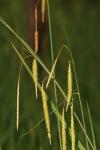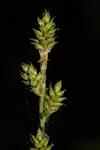Click the number at the start of a key lead to highlight both that lead and its corresponding lead. Click again to show only the two highlighted leads. Click a third time to return to the full key with the selected leads still highlighted.
1 Perigynia surfaces and beak often pubescent, finely papillate |
1 Perigynia glabrous, papillate or not. |
..2 Lateral spikes usually pedunculate; lowermost inflorescence bracts sometimes with sheath; peduncles with prophyll at base. |
....3 Terminal spike gynecandrous, pistillate flowers as many as or more numerous than staminate; lateral spikes short, not much longer than wide; fresh perigynia white-pulverulent |
....3 Terminal spike usually staminate or, sometimes, gynecandrous, staminate flowers then more numerous than pistillate; lateral spikes oblong, distinctly longer than wide; fresh perigynia green or slightly glaucous. |
......4 Pistillate scales (at least the lower) long-awned |
......4 Pistillate scales obtuse to acuminate or cuspidate. |
........5 Perigynia smooth; style persistent on the achene |
........5 Perigynia often papillose over most of the surface; style deciduous |
..2 Lateral spikes sessile; bracts sheathless; peduncles without (or rarely with) a prophyll |
..........6 Perigynia papillose (visible at 20× magnification). |
............ 7 Terminal spike staminate, androgynous, or gynecandrous (if gynecandrous, the staminate flowers more numerous than the pistillate); lateral spikes at least 2× as long as wide |
............ 7 Terminal spike staminate or gynecandrous (if gynecandrous, the pistillate flowers more numerous than the staminate); lateral spikes not much longer than wide |
..........6 Perigynia smooth. |
............ ..8 Terminal spike gynecandrous; lateral spikes gynecandrous or pistillate. |
............ ..........12 Margins of perigynia flat, at least in the upper ½, flat portion (measured at the tip of the achene and base of beak) > (0.1-) 0.2 mm wider |
............ ............ 13 Achenes rounded at apex (style dehiscing at the surface of the achene); style conspicuously enlarged at the base |
............ ............ 13 Achenes with short apiculus formed by the persistent base of the style; style not conspicuously enlarged at base |
............ ..........12 Margins of perigynia rounded, or with flat portion < 0.1 mm wide. |
............ ............ ..14 Margins of perigynia rounded or with a very narrow rounded edge; achenes nearly filling the perigynium bodies |
............ ............ ..14 Margins of perigynia sharply edged or narrowly winged; achenes distinctly smaller than the perigynium bodies. |
............ ............ ....15 Inflorescences in fruit 1-1.5× as long as wide |
............ ............ ....15 Inflorescences in fruit 1.5-2 (or more)× as long as wide. |
............ ............ ......16 Lowermost perigynia in each spike spreading |
............ ............ ......16 Lowermost perigynia in each spike ascending or erect. |
............ ............ ........17 Perigynium serrulate on the margins of the upper body and lower beak |
............ ............ ........17 Perigynium entire on the margins of the upper body and the lower beak |
............ ..8 Terminal spike androgynous (rarely entirely staminate or entirely pistillate); lateral spikes androgynous, staminate, or pistillate. |
............ ....9 Sheath fronts of lower cauline leaves transversely rugose. |
............ ......10 Perigynia mostly > 2× as long as wide, widest near the base |
............ ......10 Perigynia mostly < 2× as long as wide, widest near middle. |
............ ........11 Inflorescence usually branched, at least at the base, usually with > 15 spikes; pistillate scales usually yellow or brown, sometimes with hyaline margins, 3-veined |
............ ........11 Inflorescence unbranched or with 1 or 2 short branches at the base, with < 15 spikes; pistillate scales greenish hyaline, 1-veined |
............ ....9 Sheath fronts of lower cauline leaves smooth (or very weakly and indistinctly transversely rugose). |
............ ............ ..........18 Fronts of leaf sheaths dotted red, brown, or yellow. |
............ ............ ............ 19 Perigynia widest near the base; culms usually > 1 mm wide |
............ ............ ............ 19 Perigynia widest near the middle; culms usually < 1 mm wide. |
............ ............ ............ ..20 Plants densely cespitose, with short rhizomes; pistillate scales acute to acuminate |
............ ............ ............ ..20 Plants loosely cespitose, sometimes with long rhizomes; pistillate scales (at least the upper) obtuse |
............ ............ ..........18 Fronts of leaf sheaths not dotted red, brown, or yellow. |
............ ............ ............ ....21 Perigynium beak < 0.25 mm long, the margins entire |
............ ............ ............ ....21 Perigynium beak > 0.25 mm long, the margins often serrulate. |
............ ............ ............ ......22 Upper leaves of culms with front of sheaths green-veined, not differentiated from the rest of the sheath |
............ ............ ............ ......22 Upper leaves of culms with front of sheaths with at least a narrow hyaline or whitish-hyaline band extending at least ½ the length of the sheath. |
............ ............ ............ ........23 Perigynia with flat, winglike margins > 0.1 mm wide; plants long-rhizomatous, not cespitose, sometimes forming large colonies |
............ ............ ............ ........23 Perigynia without a flat margin, or with a flat margin < 0.1 mm wide; plants short-rhizomatous or inconspicuously rhizomatous, cespitose or not, sometimes forming large colonies. |
............ ............ ............ ..........24 Plants colonial from long rhizomes or stoloniferous (proliferating from last year’s decumbent sterile culms) |
............ ............ ............ ............ 25 Plants long stoloniferous, proliferating from last year’s decumbent sterile culms |
............ ............ ............ ............ 25 Plants rhizomatous from creeping rhizomes 1.8-3.5 mm in diameter |
............ ............ ............ ..........24 Plants cespitose. |
............ ............ ............ ............ ..26 Spikes not consistently androgynous, the terminal either entirely staminate or pistillate, the lateral spikes irregularly pistillate, or staminate, or mixed |
............ ............ ............ ............ ..26 Spikes consistently androgynous, occasionally some of the lateral spikes entirely pistillate. |
............ ............ ............ ............ ....27 Perigynium widest near the base, tapering from base to beak |
............ ............ ............ ............ ....27 Perigynium widest above the base, often abruptly beaked |

